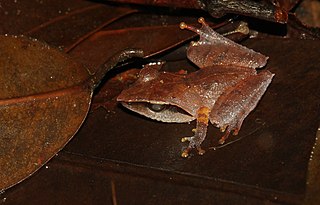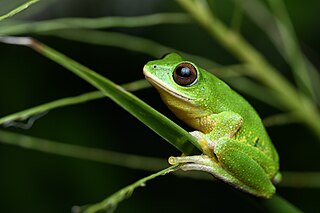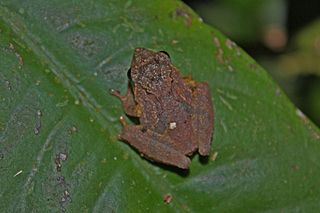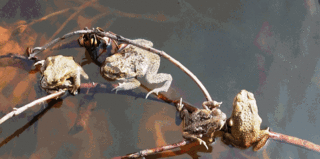
Philautus is a genus of shrub frogs in the family Rhacophoridae from Asia. Some species in this genus are now considered extinct by IUCN, while others are widespread and abundant. The taxonomy of the group is unclear, with many poorly described species.

Philautus acutirostris is a species of frog in the family Rhacophoridae. It is endemic to the Philippines, where it has been observed in rainforests on Mindanao, Jolo, and Basilan islands. Its natural habitats are subtropical or tropical moist lowland forests and subtropical or tropical moist montane forests. It is threatened by habitat loss.
Philautus acutus is a species of frog in the family Rhacophoridae. It is found in Malaysia and possibly Brunei. Its natural habitat is subtropical or tropical moist montane forests. It has been observed 300 meters above sea level in Gunung Mulu National Park.
Philautus aurantium is a species of frog in the family Rhacophoridae. It is endemic to Borneo and found in the Mount Kinabalu region in Sabah and Sarawak, Malaysia. Philautus gunungensis is sometimes considered its subspecies, Philautus aurantium gunungensis.

Pseudophilautus auratus, commonly called golden shrub frog, is a species of frog in the family Rhacophoridae, endemic to Sri Lanka, where it lives in closed-canopy cloud forests between 513 and 1270 meters above sea level, including the Sinharaja World Heritage Site and Kanneliya Forest.

Pseudophilautus caeruleus, commonly called blue thigh shrub frog, is a species of frogs in the family Rhacophoridae. It is endemic to Sri Lanka.

Pseudophilautus cuspis, commonly known as sharp-snouted shrub frog, is a species of frogs in the family Rhacophoridae. It is endemic to Sri Lanka. It has been observed between 155 and 660 meters above sea level.

Pseudophilautus decoris, commonly known as the elegant shrub frog, is a species of frogs in the family Rhacophoridae. It is endemic to Sri Lanka.
Pseudophilautus folicola, known as leaf-dwelling shrub frog, is a species of frogs in the family Rhacophoridae.

Pseudophilautus fulvus, or the knuckles shrub frog, is a species of frogs in the family Rhacophoridae.
The Leyte tree frog is a species of frog in the family Rhacophoridae. It is endemic to the Philippines.
Philautus longicrus is a species of frog in the family Rhacophoridae. It is found in Indonesia, Malaysia, and the Philippines. Its natural habitats are subtropical or tropical moist lowland forests and subtropical or tropical moist montane forests. It is threatened by habitat loss.

Pseudophilautus ocularis, known as golden-eyed shrub frog is a species of frogs in the family Rhacophoridae.

Philautus petersi is a species of frog in the family Rhacophoridae. It is found in Indonesia, Malaysia, Thailand, and possibly Brunei. Its natural habitats are subtropical or tropical moist lowland forests and subtropical or tropical moist montane forests. It is threatened by habitat loss.

The Mindoro tree frog is a species of frog in the family Rhacophoridae. It is endemic to the Philippines.
Philautus larutensis is a species of frog in the family Rhacophoridae. It is endemic to Indonesia.
Philautus surdus is a species of frog in the family Rhacophoridae. It is endemic to the Philippines and found on Bohol, Mindanao, Luzon, and Polillo islands. usually higher than 650 meters above sea level. Its natural habitats are lower montane and lowland forests, and it can also occur in some disturbed areas adjacent to forests. It is an arboreal species and one of the most common Philippine frogs inhabiting forests.
Philautus vermiculatus is a species of frog in the family Rhacophoridae. It is found in Malaysia and Thailand. Its natural habitats are subtropical or tropical moist lowland forests and subtropical or tropical moist montane forests. It is threatened by habitat loss.
Philautus worcesteri, the Mindanao bubble-nest frog, or smooth-skinned tree frog is a species of frog in the family Rhacophoridae. It is endemic to Mindanao, the Philippines.

Philautus everetti is a species of frog in the family Rhacophoridae found in the Philippines and Malaysia. Its natural habitats are subtropical or tropical moist lowland forests, subtropical or tropical moist montane forests, and rivers. In Borneo, this species occurs in the mountainous area from Gunung Kinabalu National Park in Sabah to Gunung Mulu National Park in Sarawak. It is usually observed between 750 and 1800 meters above sea level, but it is rarely seen as low as 300 meters above sea level.











